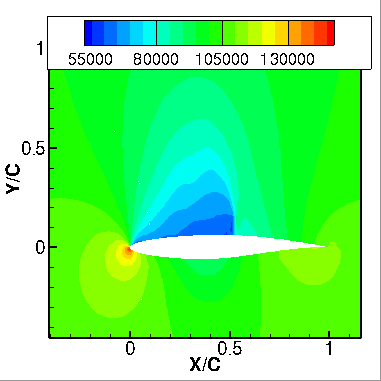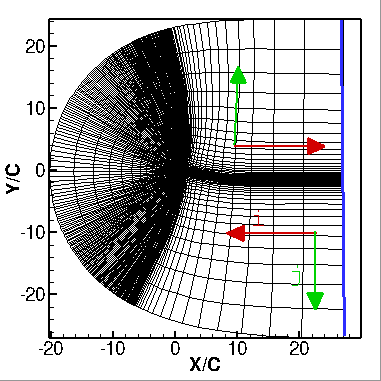RAE2822 airfoil
Transonic turbulent flow of Mach 0.72, Reynolds number 6.5 million, and angle of attack 2.92 deg over the RAE2822

Problem Statement
In this test case, a transonic turbulent flow of Mach 0.72 over the RAE2822 will be simulated. The domain used, and boundary
condition applied to the domain are illustrated in Fig. 2. The case definition and grid used were obtained from
NPARC Alliance Validation Archive.

Mesh
A structured C-grid of size 369 × 65 x 2 (with 305 grid points on the airfoil) will be used, as shown in Fig. 3. The grid is available in the tutorial folder |rootFolder|/run/Tutorial/RAE2822/CreateBlocks/.
Note
If run folder is empty, please download the content from Github
direcotry or download the zip file here.
In the blocking_point.f90
edit the number of blocks in the I-direction and J-direction. In this test case, four blocks will
be used.
integer, parameter :: xblocks = 6
integer, parameter :: yblocks = 1
To compile the blocking_point.f90 code with gfortran and execute it, commands are written
in the makefile. Just use the following command to generate the grid files in the grid/ folder.
$make
Run the previous command in the |rootFolder|/run/Tutorial/RAE2822/CreateBlocks/ directory.

Setup
To setup the case directory, a python automation script is provided: automaton.py. First, setup the most important
parameters, the paths to the grid files and main executable binary to FEST-3D
RunDir = 'RAE2822' Name of the run directory to create for current case.
GridDir= 'CreateBlocks/grid/' Path to the folder which only contains grid file.
NumberOfBlocks = 6 Total number of blocks. It should match with number of gridfiles avaiable in the GridDir folder
AbsBinaryPath="/home/usr/FEST3D/bin/FEST3D"
Absolute path to the FEST-3D binary. Should be in |rootfolder|/bin/FEST3D
Now provide the common control parameters.
Control['CFL'] = 100.0 High CFL since implicit time-integration method will be used.
Control['LoadLevel'] = 0Since simulation will be started from scratch, 0 is specified.
Control['MaxIterations'] = 10000 Maximum number of iteration to perform.
Control['SaveIterations'] = 1000 Solution folder will be written every 1000 iteration.
Control['OutputFileFormat'] = 'vtk' Type of solution file to write. If you have tecplot file viewer you can user tecplot instead of vtk
Control['Purge'] = 1 Only one latest solution folder will be kept in the time_directories and rest will be deleted.
Control['ResidualWriteInterval'] = 20Write residual in time_directories/aux/resnorm after every 5 iteration.
Control['Tolerance'] = "1e-13 Continuity_abs" Stop the iteration if the absolute residual value of continuity equation is less than 1e-13.
Few scheme parameters for inviscid flow:
Scheme['InviscidFlux'] = 'ausm' Inviscid flux-reconstruction shceme. You can use: slau, ldfss0, ausmP , and ausmUP instead of __ausm.
Scheme['FaceState'] = 'muscl' Higher-order face-state reconstruction method. you can use: none, ppm, and weno.
Scheme['Limiter'] = '1 1 1 0 0 0' Switch on the limiter for I,J,and K direction and switch off pressure based switching for all direction.
Scheme['TurbulenceLimiter'] = '1 1 1' Using limiter only for turbulent variables face-state reconstruction improve convergence.
Scheme['TurbulenceModel']='sst' using SST turbulence model. Other models kkl, sa, and sst2003 can be user also.
Scheme['TransitionModel']='none' none is metioned for no transition model.
Scheme['TimeStep']='l' Local time stepping method. You can use global time-stepping method also g.
Scheme['TimeIntegration']='implicit' LU-SGS matrix-free time integration method.
Now, lets define the flow feature of test case:
Flow["DensityInf"] = 1.2 Free-stream density.
Flow["UInf"] = 252.9 Free-stream x-component of velcotiy vector. (Mach = 0.5 at T_ref=300K)
Flow["VInf"] = 10.2 Free-stream y-component of velcotiy vector.
Flow["WInf"] = 0.0 Free-stream z-component of velcotiy vector.
Flow["PressureInf"] = 103338.0 Free-stream pressure.
Flow["TurbulenceIntensity"] = 1.0 Free-stream turbulence intensity.
Flow["ViscosityRatio"] = 10.0 Free-stream viscosity ratio.
Flow["Intermittency"] = 1.0 Free-stream intermittency.
Flow["ReferenceViscosity"] = 1.4243-5 Reference viscosity is set such that the Reynolds number (L_ref=1m) is 5 million
Flow["ViscosityLaw"] = "sutherland_law"``` Viscosity variation law.
OutputControl['Out'] = ["Velocity", "Density", "Pressure", "Mu"] Variables to write in the output file.
ResidualControl['Out'] = ["Mass_abs", "Viscous_abs", "Continuity_abs"] Residual to write in the resnorm file.
BoundaryConditions = [-4, -4, -5, -8, -6, -6] Broad boundary condition.[subsonic outlet, no-slip wall, far-field, and slip wall for rest ].
Rest of the variables should be left to their default value. To execute this script, use the following command:
$python automaton.py
Now, you will see a new folder created with RunDir name (RAE2822). Switch to that directory to run the test case. To make sure setup is correct, check
the layout.md file located in system/mesh/layout/layout.md. The file should look like the following:
## BLOCK LAYOUT FILE ## ========================== ## NUMBER OF PROCESSES 6 ## NUMBER OF ENTRIES PER PROCESS 9 ## PROCESS_NO GRID BC_FILE IMIN IMAX JMIN JMAX KMIN KMAX ## =================================== ## PROCESS 0 00 grid_00.txt bc_00.md -004 0001 0005 -008 -006 -006 ## PROCESS 1 01 grid_01.txt bc_01.md 0000 0002 -005 -008 -006 -006 ## PROCESS 2 02 grid_02.txt bc_02.md 0001 0003 -005 -008 -006 -006 ## PROCESS 3 03 grid_03.txt bc_03.md 0002 0004 -005 -008 -006 -006 ## PROCESS 4 04 grid_04.txt bc_04.md 0003 0005 -005 -008 -006 -006 ## PROCESS 5 05 grid_05.txt bc_05.md 0004 -004 0000 -008 -006 -006
Finally, to run the simulation use the following command:
$nohup bash run.sh &
nohup helps in avoiding any output on the screen, & execute the last command in the background, allowing you to keep using the terminal.